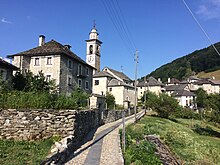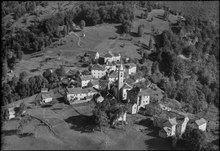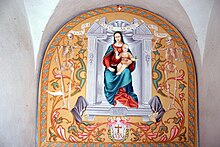Rasa TI
| TI is the abbreviation for the canton of Ticino in Switzerland and is used to avoid confusion with other entries of the name Rasa . |
| Rasa | ||
|---|---|---|
| State : |
|
|
| Canton : |
|
|
| District : | Locarno district | |
| Circle : | Melezza district | |
| Municipality : | Centovalli | |
| Postal code : | 6655 | |
| Coordinates : | 693 936 / 112333 | |
| Height : | 898 m above sea level M. | |
| Residents: | 12 (December 31, 2015) | |
| Website: | www.intragna.ch | |
|
Rasa TI |
||
| map | ||
|
|
||
Rasa is a small mountain village in Centovalli , which belongs to the Ticino municipality of Centovalli , which was formed in 2009 .
geography
The car-free village is located on a terrace on the southern slope of the Centovalli , about 900 m above sea level. Today around ten people live in the village all year round. The former mountain farming village is now primarily a holiday resort and popular excursion destination for hikers thanks to its wide view of the Valais Alps and access by cable car from the Verdasio stop of the Centovalli Railway .
history
Rasa was founded in 1700 when the inhabitants moved from the lower-lying area of today's Terra Vecchia to Rasa (and immediately took the name Rasa with them). In 1753 the Church of St. Anna was built in Rasa. Since 1957, Rasa can be reached by cable car from Verdasio.
In 1864, Rasa split from the municipality of Palagnedra and became an independent political municipality . The independence ended on January 1, 1972 with the incorporation into the municipality Intragna , which in turn became part of the municipality Centovalli in October 2009 .
The beginnings in Terra Vecchia
Rasa was first at the place now called Terra Vecchia , on the footpath from Rasa to Bordei and Palagnedra. Ecclesiastically and under civil law, the place belonged to Palagnedra . On June 25, 1615, the single-nave church (12 × 6 m) with a wooden ceiling was consecrated to the Madonna della Neve in Terra Vecchia. In 1636 the ecclesiastical authorities gave permission to bury the dead in the church, who had previously had to be buried in Palagnedra. In 1643 what was then Rasa and its factions were elevated to an independent parish. In the second half of the 17th century this numbered about 200 souls, a hundred years later only 110. More and more people left today's Terra Vecchia - some of them settled in today's village of Rasa, which previously had the name Digessio as a fraction .
Rasa
The municipality of Rasa was one of the smallest in Ticino and one of the villages hardest hit by the depopulation. Today Rasa can be reached by cable car from Verdasio, on foot from Palagnedra, Ronco, from Intragna over the Roman bridge or from Corcapolo over the bridge of Salmina.
The stones used as building material for the village were found in abundance in the soil, in the fields and in the forests. Lime was carried up on the back for an hour from Bordei or from Monte di Remo. The rock slabs for the roofs (period) had to be carried from deadlines, 40–50 kg per load. The stone steps were also hewn far away from the village and carried on their shoulders in twos.
At the beginning of the 18th century, perhaps even earlier, Rasa had its own school. After the church was built, it was installed above the sacristy, until it was finally closed in 1950 in the rectory next to the church. In 1930 16 students were still being taught. Today the children go to elementary school in Intragna and middle school in Losone or Locarno .
The church and the village give the impression of a certain wealth. Around 1630 the Rasans began to emigrate to Livorno , where they had a monopoly as porters . Others went to Milan and Rome , and to America in the late 19th century. The people who remained in the village, mainly women and children, devoted themselves to agriculture. They made butter and cheese and organized the mazza ( butcher's tote ), smoked chestnuts and kept a herd of several hundred sheep, cows and goats (in 1930 there were 200 animals). Each family also owned at least one pig. Meat and sausage were provided for the whole year. Fish were found in the nearby watercourses, especially in the Ri di Progia .
In addition, nuts were collected and brought to Palagnedra for the production of cooking and lamp oil. Almost all agricultural implements were made by the Rasans themselves, as were the cloth shoes (pedüü) . The wool was also spun, dyed and processed in the village.
For food that could not be obtained locally, one had to go to the shops in Palagnedra, Intragna or Locarno; of course there and back on foot, summer and winter, with loads of 50 kg and more. An old man told the chronicler Carlo Prada that in winter you sometimes had to go to Losone to buy straw when the hay was running out - even on foot or on skis. A calf was very valuable. Selling a calf made it possible to stock up on essentials for half a year. On the other hand, if an animal perished, the consequences for the families concerned were dire.
In case of illness, the doctor from Intragna was called. In general, however, the sick were carried to Corcapolo, for which the church's carrying chair was available. Most of the children were born at home. The woman who had recently given birth, who mostly went about her work to the last moment, was assisted by a woman from the village who was a midwife.
Since the Italian population put pressure on the Ticino porters, the Tuscan Grand Duke Leopold II lifted the sole right to carry the load forever in August 1847. Those who had found work at the court of Florence suffered the same fate; they too were dismissed from their posts. The good sources of income dried up and the young began to emigrate. Within fifty years the population has halved. In 1971 Rasa only consisted of twelve residents. At that time it was abolished as a community and from then on belonged to Intragna.
Population development
While Rasa had around 200 inhabitants around 1500 and around 300 inhabitants around 1900, there were only 11 in 1970. Since 1962, several abandoned houses have been renovated, rebuilt and re-used as the Campo Rasa, a Christian education and holiday center of the United Bible Groups contributed to the locality, village life and mountain farming.
Attractions
- Ortbild: The village is a well-preserved Ticino village.
- The parish church of Sant'Anna is a single-nave building with side chapels and a square choir, 17.5 m long and 10 m wide, single-nave with three altars . Construction began on August 5, 1747 according to plans by Filippo Martinola and was completed on November 11, 1753; the paintings are from the 19th century. The altars were donated by the Rasans when they still had work in Florence and Livorno . The church is equipped with an organ built in 1840 by Pietro Minoletti from Val Vigezzo. It cost 11 lire in 1548, including the choir, which was later painted by Antonio Ciseri in the 16th century style. It is said that a kid was given to him for this work. Thanks to the Council of Churches and various donations, the organ was restored in 1983 by Italo Marzi from Bergamo.
- A law of 1842 forbade the custom of burying the dead in church. A cemetery was created next to the church of Terra Vecchia, towards the end of the 19th century in Rasa. The bell tower was built in 1764, the Rasans acquired the first bell in 1747 and the second in 1774. This was poured in Intra and cost 1,700 lire. For the third bell, also cast in Intra, 736 lire was paid two years later. But people found these bells too small; so they were melted down in the foundry of Antonio Maria Comerio in Malnate in 1836 . The five new, larger bells cost 5659 lire.
- In 1779 the tower clock was installed with weights. It was later replaced by an electric clock.
- In 1778 Antonio Caldelli from Brissago painted the background of the choir. Also noteworthy is the large oil painting depicting St. Anne, St. Jacob and Mary as a child. It is the work of Pietro Ligari from Sondrio (born February 18, 1686 in Ardenno, † April 6, 1752 in Sondrio). It was donated in 1750 by pastor Domenico Borga, who bought it from the Borgo Canale church in Bergamo for 22 gold coins
- Salmina Bridge: At the end of the 18th century, the people of Corcapolo decided to build a bridge over the Melezza . The work was completed with great effort and expense; however, the bridge collapsed on the day of the endurance test. So the river still had to be crossed or waded on dangerous bridges; quite a few accidents happened. In 1871 the carpenter Domenico Maggini and the farrier Gottardo Cavalli began building a new bridge with the help of other craftsmen. On July 13, 1873, the first bridge in the canton of Ticino to be suspended from wire ropes was inaugurated. In 1976 it was replaced by a new design.
Economy and Infrastructure
- Verdasio – Rasa cable car
As early as 1928 there was talk of opening up Rasa as the last place in Ticino by road or cable car . The decision was made in favor of the cable car, which was built in 1957. In 1978, the Grand Council of the Canton of Ticino granted a loan of 1,000,000 Swiss francs, and on May 4, 1979 the renovated aerial tramway with double the payload went into operation. In 1982 over 50,000 people were transported.
Personalities
- Giovanni Borga (born March 22, 1657 in Rasa, † January 3, 1716 in Mosogno ), priest, pastor in Mosogno
- Antonio Maria Borga (born May 3, 1722 in Rasa, † 1768 in Venice ), priest, pastor of Lepreno, fraction of the Serina parish and poet
literature
- Rodolfo Huber: Intragna. In: Historical Lexicon of Switzerland . January 11, 2017 , accessed January 9, 2020 .
- Art guide through Switzerland. Volume 2. Edited by the Society for Swiss Art History . Completely revised edition, Bern 2005, ISBN 3-906131-96-3 , p. 633.
- Simona Martinoli u. a .: Rasa. In: Guida d'arte della Svizzera italiana. Edited by the Society for Swiss Art History. Edizioni Casagrande, Bellinzona 2007, ISBN 978-88-7713-482-0 , p. 217.
- Carlo Prada: Records of the Rasa Parish. 1911.
- Elfi Rüsch: Rasa. In: Distretto di Locarno IV. Ed. By the Society for Swiss Art History. Bern 2013, ISBN 978-3-03797-084-3 .
- Celestino Trezzini : Rasa. In: Historisch-Biographisches Lexikon der Schweiz , Volume 5: Pictet - Resti. Attinger, Neuchâtel 1929, p. 540 ( digitized version ).
Web links
- Official website of the Municipality of Centovalli
- Centovalli municipality data
- Office for Statistics of the Canton of Ticino: Centovalli (Italian)
- Camporasa, Christian education and holiday center
- Federal inventory ISOS: Rasa (PDF; 913 kB)
- Catalogo ASTI, Rasa at www3.ti.ch/DECS/dcsu/ac/asti/cff/ (accessed December 10, 2017).
- Website of the Museo Regional delle Centovalli e Pedemonte (Italian)
- Rasa on ticinotopten.ch
- Rasa on elexikon.ch
Individual evidence
- ↑ a b c d e Simona Martinoli and others: Guida d'arte della Svizzera italiana. Edited by the Society for Swiss Art History. Edizioni Casagrande, Bellinzona 2007, ISBN 978-88-7713-482-0 , p. 217.
- ^ A b c d e Elfi Rüsch: Distretto di Locarno IV. Ed. By the Society for Swiss Art History. Bern 2013, ISBN 978-3-03797-084-3 , pp. 224-233.
- ↑ Helge von Giese: A soul garden in Centovalli. In: Neue Zürcher Zeitung , August 3, 2012.
- ^ Gian Casper Bott: Pietro Ligari. In: Sikart (status: 1988) (accessed on: April 28, 2016.)
- ↑ Giovanni Borga at biblio.unibe.ch/digibern/hist_bibliog_lexikon_schweiz (accessed on June 29, 2017).
- ↑ Antonio Maria Borga on biblio.unibe.ch/digibern/hist_bibliog_lexikon_schweiz (accessed on June 29, 2017).
- ^ Flavio Catenazzi: Antonio Maria Borga. In: Historical Lexicon of Switzerland . May 13, 2004 , accessed April 10, 2020 .










